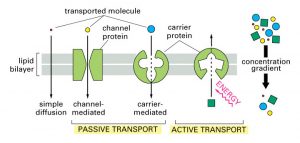Principles of Membrane Transport
Membrane transport: It is the passage of metabolites, by-products and biochemicals across biomembrane. Membrane transport occurs through four methods–passive, facilitated, active and bulk. Size of the particles passing through plasmalemma is generally 1 – 15 Å.
(i) Passive transport: No energy spent. Passive transport occurs through diffusion and osmosis.
(a) Diffusion: It is the movement of particles from the region of their higher concentration or the electrochemical potential to the region of their lower concentration or electrochemical potential. Electrochemical potential operates in case of charged particles like ions. Diffusion can be observed by opening a bottle of scent or ammonia in one corner, placing a crystal of copper sulphate in a beaker of water or a crystal of on a piece of gelatin. Simple diffusion does not require carrier molecules.
Independent Diffusion: In a system having two or more diffusion substances, each individual substance will diffuse independently of others as per gradient of its own concentration, diffusion pressure or partial pressure form region of higher one to the region of the lower one. Rate of diffusion is proportional to the difference in concentration and inversely to distance between the two ends of the system, inversely to the square root of the relative density of substance and density of the medium, directly to temperature and pressure.
(b) Osmosis is the diffusion of water across a semipermeable membrane that occurs under the influence of an osmotically active solution.
(c) Mechanism of passive transport: Passive transport can continue to occur if the absorbed solute is immobilised. Cations have a tendency to passively pass from electropositive to electronegative side. While anions can pass from electronegative to electropositive side. There are two modes of passive transports.
Lipid matrix permeability: Lipid soluble substances pass through the cell membrane according to their solubility and concentration gradient, e.g., triethyl citrate, ethyl alcohol, methane.
Hydrophilic membrane channels: They are narrow channels formed in the membrane by tunnel proteins. The channels make the membrane semipermeable. Water passes inwardly or outwardly from a cell through these channels according to osmotic gradients. and also diffuse through these channels as per their concentration gradients. Certain small ions and other small water-soluble solutes may also do so.
(d) Ultrafiltration is fine filtration that occurs under pressure as from blood capillaries, epithelia and endothelia. It is of two types: – Paracellular through leaky junctions or gaps in between cells. Transcellular through fenestrations in the cells. ‘Dialysis’ is removal of waste products and toxins from blood by means of diffusion between blood and an isotonic dialysing solution.
(e) Facilitated transport or Facilitated diffusion : It is passage of substances along the concentration gradient without expenditure of energy that occurs with the help of special permeating substances called permeases. Permeases form pathways for the movement of certain substances without involving any expenditure of energy. At times certain substances are transported along with the ones requiring active transport. The latter phenomenon called cotransport. Facilitated transport occurs in case of some sugars, amino acids and nucleotides.

(ii) Active transport: It occurs with the help of energy, usually against the concentration gradient. For this, cell membranes possess carriers and gated channels.